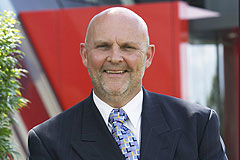News - VFACTS - Sales 2006Big sixes lose gloss as car buyers turn to economyDominant leader: Toyota managed sales wins across its range. VFACTS results show Aussie car buyers deserting large cars5 Jan 2007 INTEREST rates, volatile fuel prices and changing buyer patterns have converged to significantly dent Australia’s large car love affair. In the latest Federal Chamber of Automotive Industries VFACTs figures, light and small cars dominated the sales charts in 2006 with large car sales slipping 18.4 per cent, despite the arrival of GM-Holden’s new $1 billion VE Commodore, Toyota Aurion V6 and a facelifted Ford Falcon. Falcon managed an overall large car share of 32.6 per cent with 42,390 sales while the Commodore held on to No1 passenger car spot with a 43.4 per cent share, despite sales slipping to 56,531. Mitsubishi’s valiant 380 managed 12,423 sales last year, a large car share of 9.5 per cent. Overall, Toyota was the country’s most popular brand, managing a 22.2 per cent market share and cementing its number one spot for the fourth straight year. The mighty brand also became the market leader in passenger cars with 114,775 sales for the first time in its 43-year history in Australia. Toyota’s Corolla managed to secure number two sales spot with sales of 46,256, edging out the Falcon while the Yaris, Camry and HiLux also posted impressive sales. The company’s petrol-electric hybrid Prius also garnered a strong following, with 1974 sold last year, up 38.7 per cent over 2005. More than 5000 first and second-generation Priuses have now been sold in Australia. As imports continue to grab the lion’s share of overall sales, locally made cars fell from 248,912 in 2005 to 201,623 last year, a drop of 19 per cent. Imports also lifted their share from 74.8 per cent in 2005 to 79 per cent last year. Despite the sour note for big sixes, the FCAI’s chief executive, Peter Sturrock, believes there are signs that sales could improve this year based on the late new model activity of last year. “Australians have not fallen out of love with large cars and in common with almost every other market in the world it is likely we will continue to buyer the most space, power and performance that we can afford,” he said. Despite a rocky year for large cars, total sales hit 962,521 in 2006, the second highest sales figure on record. The result was significantly greater than 2004 and just 2.6 per cent down on the record set in 2005. According to FCAI chief executive, Peter Sturrock, the buoyant year was evidence “that over the past few years the Australian motor vehicle industry has shifted into a higher gear”. With Toyota safe in number one spot, second, third and fourth spot remained with Holden, Ford and Mazda. Holden managed a 15.2 per cent market share, Ford 11.9 per cent and Mazda 6.6 per cent, their finishing positions unchanged from the previous year. However, behind the top three were some positional changes. Mitsubishi (5.6 per cent), Nissan (5.5 per cent) and Hyundai (4.8 per cent) dropped one spot each, all three leapfrogged by Honda (5.6 per cent) in what was an extremely tight sales tussle.  Left: Toyota's David Buttner is bullish about 2007. Left: Toyota's David Buttner is bullish about 2007.In a stellar year for Volkswagen, the German brand moved into the top 10 by taking the spot previously held by Kia. Within the overall market there were mixed fortunes across most vehicle segments. Mr Sturrock said the light and small car result was “the biggest story”. The light car class grew by 20,196 vehicles or 21.2 per cent to reach 116,086 vehicles on the back of fluctuating petrol prices. However, the FCAI believes more consumers were also shifting to more economical small cars because they were roomier, more practical and “better specified for the money than ever before”. But Mr Sturrock also said there was evidence many light cars were bought by parents for their children as new cars rather than buying a second hand vehicle. “And we might consider that the increasing emphasis on environmental sensitivities and urban congestion also played a part in the greater popularity of these light cars,” he said. Conversely, the higher petrol prices did not really help the small car segment, with sales rising only fractionally last year and actually fallen in the second half of the year. Market trends last year were far from uniform. In contrast to the growth in sales of smaller cars, the luxury SUV segment improved as well, by 10.5 per cent and the SUV compact segment also grew by 4.1 per cent. Among light trucks sales of 4x4 pickup and cab chassis segment grew strongly by 7.8 per cent. Many of them sold as much for private use as for tools of trade. On the other side of the ledger the medium SUV segment suffered a sales downturn, falling 15.2 per cent. The FCAI has forecast 2007 sales at 970,000, a lift of just 1 per cent over last year in what it believes will be a steady year. “The consensus among motor industry leaders is that the market will continue to motor at the same high speed it has in recent years,” Mr Sturrock said. “The FCAI believes there is no reason any significant downturn in sales in the foreseeable future.” Toyota is more bullish with its senior executive director of sales and marketing, David Buttner tipping 980,000 vehicles. “We’re slightly optimistic about the overall market and our current thinking is that it will grow slightly further to around 980,000 sales,” he said. Toyota’s confidence stems from a full year contribution of Aurion V6 sales and a range of new models, including the next-generation Corolla, which is due in showrooms in a matter of months. |
Click to shareVFACTS articlesResearch VFACTS Motor industry news |














Facebook Twitter Instagram